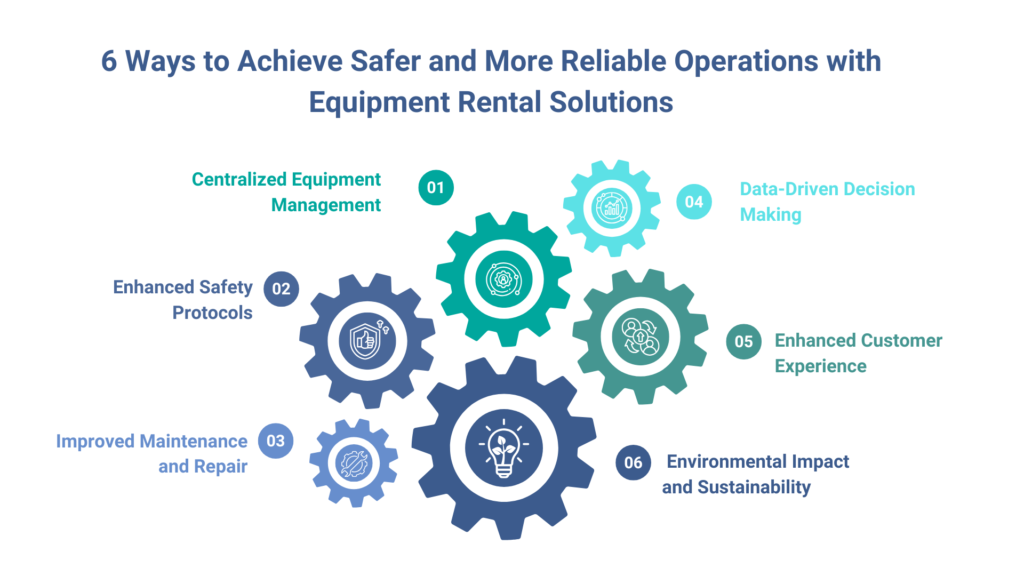Oilfield operations are extremely demanding, and safety and reliability are paramount. Equipment rental companies face a complex set of challenges, and traditional methods struggle to meet the efficiency and precision needed to prevent operational downtime, ensure worker safety, and manage environmental impact.
Digital solutions are transforming how companies tackle these critical issues. Equipment rental software offers a centralized platform that helps minimize risks and boost productivity, all while adapting to the industry’s evolving regulatory and environmental standards.
Let’s explore how digital equipment rental solutions enhance safety, reliability, and sustainability and offer a smarter, more proactive way to manage rental operations.
Oilfield operations are high-stake, and mistakes can not only be costly but also detrimental. Outdated equipment management methods can introduce serious challenges.
Here are some of the main issues oilfield equipment rental companies face when they rely on traditional approaches:
Manual processes and older equipment often lead to a higher risk of safety incidents and unexpected downtime. When field teams track equipment conditions and operational schedules by hand, it’s easy for small issues to go unnoticed until they escalate.
This can lead to breakdowns at critical times, risking not only operational delays but also worker safety. Furthermore, misallocating resources or equipment due to outdated information can result in significant disruptions. This forces teams to divert time and effort to address preventable issues.
In addition, frequent equipment rentals mean operators may not be fully familiar with the specific equipment they’re handling, which increases the risk of misuse or operational errors. Rental equipment also often lacks standardized emergency procedures that address the specific safety needs of each unique rental item. Without clear guidelines, operators may be unprepared to respond quickly in emergencies, increasing the risk of accidents.
Finally, differing maintenance and repair standards between rentals can lead to inconsistent performance, which may compromise safety. Without clear protocols for inspecting and certifying rental equipment after each use, the risk of equipment failure or malfunction during field operations is higher.
Compliance with OSHA and other regulatory standards is crucial in oilfield equipment rentals to ensure safe operations and protect both workers and assets. The oil and gas sector is subject to stringent OSHA requirements for hazard management, machine guarding, and confined space entry, among other areas.
Equipment rental companies are responsible for ensuring that all rental assets meet these standards before deployment.
Regular safety inspections, up-to-date certification documentation, and adherence to industry best practices in maintenance are essential for compliance. Furthermore, digital solutions can simplify compliance by automating safety documentation and creating a clear audit trail that demonstrates adherence to these regulatory standards.

When companies use traditional systems to track equipment data, they often lack real-time visibility into the status and condition of their assets. The absence of immediate, accurate information can result in inefficient decision-making and delayed responses to maintenance needs. This can ultimately slow down operations.
Due to the lack of real-time data, teams may not know when a piece of equipment is approaching failure. As a result, you may need to deal with higher costs for emergency repairs and increased downtime. Accurate tracking and timely responses are essential for maintaining reliable and efficient operations. Without digital solutions, this can be difficult to achieve.
Inefficient equipment management can significantly increase an oilfield operation’s environmental footprint. Outdated tracking systems and maintenance practices can lead to excess fuel consumption, unnecessary emissions, and more frequent equipment replacements due to improper usage.
For companies aiming to reduce their environmental impact and adhere to sustainability goals, traditional management methods often fall short. Excessive wear and tear on equipment from inefficient practices also drives up costs and negatively impacts the long-term sustainability of operations.
Equipment rental software is transforming how companies approach safety and compliance. Comprehensive solutions integrate features such as real-time monitoring, automated compliance checks, and streamlined maintenance management into a single platform.
It reduces risks, enhances accountability, and fosters a culture of safety that traditional methods simply cannot match.

Centralizing key functions such as real-time tracking, preventive maintenance scheduling, and compliance documentation helps companies address the unique challenges of oilfield rentals. This, in turn, helps foster a safer, more efficient, and compliant operation.
With GPS-enabled tracking, oilfield companies gain live visibility over the location and condition of their rental equipment. This real-time data allows operations teams to closely monitor asset usage and set up data-driven alerts to detect irregularities.
For example, if equipment deviates from an expected location, automated alerts can immediately notify the team. This can prevent misuse and reduce the likelihood of asset loss, damage, or misplacement and related costs.
Equipment downtime can be costly, impacting both productivity and safety. Automated scheduling systems powered by IoT allow for maintenance to be conducted proactively based on usage and equipment condition rather than a fixed schedule.
IoT insights enable predictive maintenance, which prevents unexpected breakdowns by flagging issues early. For instance, sensors can detect wear-and-tear indicators like increased vibration or temperature changes. As a result, teams act before a failure occurs, significantly extending the asset’s lifespan and reducing the environmental impact.
Managing inventory effectively means not only tracking equipment but also ensuring compliance with regulatory standards such as OSHA and similar. Centralized documentation systems make it easier to maintain and access the records necessary in case of safety audits and inspections.
Digital platforms allow oil and gas companies to house /data such as inspection logs, certification records, and safety documentation in a single place. Therefore, oilfield companies can streamline compliance, reduce paperwork, and create an easily traceable audit trail.
Safety protocols are critical to protect workers, ensure equipment reliability, and maintain regulatory compliance. Equipment rental software provides essential tools that allow companies to enforce and enhance these protocols with accuracy and efficiency, ensuring that every aspect of safety is systematically managed.
Automated digital inspection checklists help ensure rigorous safety standards. Instead of relying on paper-based inspections or manual checklists, digital tools provide structured, step-by-step pre- and post-rental inspections that they automatically record and store. This allows teams to standardize safety checks. As a result, they can reduce the risk of human error and ensure that each piece of equipment meets safety requirements before it reaches the field.
Furthermore, digital records are easily accessible and provide a quick and reliable reference for safety audits and inspections. By making inspections both thorough and traceable, digital checklists contribute to safer, more dependable operations.
A crucial part of equipment safety lies in proper training and education for all operators and field personnel. With rental equipment, operators may be unfamiliar with specific features or safety protocols required for certain machines, which can increase risk.
Structured training programs covering accident prevention, emergency procedures, and equipment handling ensure that operators know how to respond to potential risks. Additionally, emergency procedures should be clearly outlined and communicated to all operators to enhance safety preparedness.
Digital platforms can also track certifications, alert management when renewals are due, and enable easy access to training resources. Continual education and safety refreshers build a skilled, informed workforce that is prepared to handle rented equipment safely and effectively.
Accurate incident reporting is crucial for identifying safety risks and taking preventive measures. Equipment rental software simplifies the incident logging process by making it easy to document and categorize each occurrence in real time. This data is then available for trend analysis, which allows teams to identify recurring issues, spot potential hazards, and proactively adjust safety protocols.
By analyzing incident trends, companies can implement targeted improvements to prevent similar incidents in the future. This helps create a safer and more responsive work environment. Additionally, comprehensive incident records support transparency and are invaluable for compliance audits and reporting to regulatory bodies.
Efficient maintenance is necessary to keeping oilfield operations safe, compliant, and productive. Unfortunately, traditional maintenance methods often rely on reactive measures, which lead to unplanned downtime, safety risks, and higher costs.
With equipment rental software, companies can embrace a proactive, data-driven approach that minimizes these challenges.
Predictive maintenance is helping oilfield companies move away from a reactive approach to one that anticipates and prevents issues. By leveraging IoT-driven insights, sensors continuously monitor equipment for signs of wear and tear, such as abnormal vibrations or temperature spikes.
This real-time data allows teams to detect small issues before they turn into costly breakdowns. Companies can offer timely repairs that prevent prolonged downtime.
Not only does predictive maintenance reduce operational interruptions, but also the fuel and emissions resulting from frequent equipment replacements and repairs. This, in turn, minimizes the environmental impact.
Effective work order management is crucial for handling repairs and maintenance tasks in real time. With digital work order systems, teams can create, assign, and track maintenance tasks from one centralized platform.
Automated scheduling then allows teams to efficiently prioritize tasks based on equipment usage and condition, making sure that high-priority repairs are completed promptly. This not only streamlines workflows but also prevents overlapping tasks and resource misallocations.
Real-time updates keep everyone in the loop, making work order management the key to efficient, responsive maintenance practices. By organizing maintenance with digital precision, companies can reduce downtime and keep equipment running reliably.
To mitigate risks that come with rental equipment, companies should track details about each stage of the rental process. These include conducting thorough pre-rental inspections, during which teams verify the condition of the equipment and complete any necessary repairs are completed.
Post-rental, companies should carry out a comprehensive inspection to document the equipment’s condition and ensure it is safe for future rentals. Implementing digital tools to manage these steps provides a systematic and traceable approach to rental equipment safety.
Digital solutions provide easy access to each asset’s complete maintenance history, including past repairs, inspections, and parts replacements. This historical data helps maintenance teams identify trends, anticipate future service needs, and effectively prioritize preventive maintenance.
Moreover, comprehensive maintenance records simplify compliance audits by providing a ready reference for regulatory reporting. Digital maintenance tracking supports a transparent, audit-ready approach that minimizes regulatory risks and builds operational resilience.
Equipment rental software brings data insights into every layer of operations, from performance analytics to risk assessments and seamless system integration. By strategically using data, oilfield companies can optimize processes, enhance compliance, and improve overall efficiency.
Understanding equipment usage is key to optimizing operations and minimizing unnecessary costs and emissions. With performance analytics, companies gain a complete view of each rental asset’s usage patterns, efficiency, and idle time.
By analyzing this data, teams can identify trends that help optimize rental schedules. As a result, they can ensure that they deploy equipment where it’s needed most and reduce the time it spends idling.
Such a level of optimization not only boosts productivity but also supports sustainability goals by cutting down on emissions and fuel consumption associated with idle machinery.
Compliance and safety are paramount in the oilfield industry. However, traditional reporting methods can be time-consuming and prone to error.
Digital solutions simplify these processes by generating automated compliance reports that adhere to OSHA and other industry standards. Real-time risk assessment tools also allow companies to proactively evaluate safety hazards and operational risks, minimizing the potential for costly incidents and regulatory violations.
With automated compliance and risk reporting, oilfield companies can maintain a high standard of safety and transparency. They can ensure regulatory readiness while protecting their workforce and assets.
A streamlined flow of information is essential for coordinated, efficient operations. Equipment rental software seamlessly integrates with ERP, accounting, and project management platforms. This allows critical data to move freely across departments, reduces the need for manual data entry, and minimizes errors.
Thus, rental businesses can ensure that financial, operational, and project-specific data are accurate and up-to-date.
Delivering a superior customer experience is essential in the competitive oilfield industry, where downtime can significantly impact client operations. Equipment rental software enhances customer satisfaction by providing accurate delivery scheduling, real-time communication, and proactive support, ensuring that clients receive the reliable service they need to keep their projects on track.
Timely equipment delivery and pickup are vital to minimizing downtime and maintaining efficient operations. Equipment rental software allows companies to optimize delivery logistics by coordinating schedules according to real-time data and equipment availability.
This means clients receive their rentals on time, and there are fewer costly delays, allowing them to proceed with their projects as planned. The ability to track and dynamically adjust schedules ensures that logistics align closely with client needs, fostering trust and reliability.
With optimized scheduling, equipment rental companies can reduce downtime-related costs and enhance operational efficiency for their clients.
In any service-oriented industry, clear communication builds customer confidence. Through a customer portal, companies can provide clients with real-time updates on equipment availability, condition, and delivery status.
Whether clients need to know when a piece of equipment will arrive or check its maintenance history, this transparency empowers them with the information they need to make informed decisions.
Real-time notifications make sure customers are in the loop every step of the way. This improves satisfaction and reduces the need for last-minute inquiries.
Using predictive analytics, equipment rental software enables proactive customer support. It anticipates and resolves potential issues before they affect client operations. Predictive insights alert support teams to potential equipment malfunctions or maintenance needs. Thus, they can address such issues proactively.
This approach not only prevents unexpected breakdowns but also demonstrates to clients that their service provider is committed to keeping their operations running smoothly.
Rapid issue resolution and proactive outreach build client trust. So, customer support does not only address issues but becomes a partnership built on reliability and responsiveness.
The Paris Agreement expects the U.S. and other countries to cut emissions by 55%. Meanwhile, energy is among the three highest-emitting sectors. Because of this, the oil and gas space is increasingly focused on environmental responsibility.
Companies must continuously adapt their operations to meet industry standards and regulations. Therefore, efficient equipment usage and sustainability are critical to long-term success.
Equipment rental software supports oilfield companies in reducing their environmental footprint and driving greener, more sustainable operations.
Efficient equipment management is key to reducing waste and lowering the environmental impact of oilfield operations. Real-time tracking and data insights that digital tools provide allow companies to continuously monitor equipment status and usage. So they can ensure the optimal use of assets.
This level of visibility helps teams to minimize unnecessary idle time, streamline equipment rotations, and avoid resource-heavy overuse. By maximizing operational efficiency, companies reduce emissions and fuel consumption, which helps to lower the carbon footprint associated with oilfield operations.
Studies have shown that IoT-driven asset management can cut energy costs and emissions by up to 20%. It makes digital solutions a vital component of sustainable business practices.
Environmental regulations are increasingly strict. Oilfield companies must stay compliant to avoid costly penalties and support sustainability goals.
Equipment rental software simplifies compliance by automatically documenting equipment usage patterns, maintenance records, and emissions data. This not only helps teams meet regulatory requirements but also ensures readiness for environmental audits.
The software’s ability to track eco-friendly practices, such as idle time reduction and emission control, helps companies remain committed to sustainable operations. They can both protect natural resources and build trust with stakeholders, who expect a commitment to sustainability.
In the oilfield industry, reducing costs while maintaining high operational standards is vital. Comprehensive digital solutions like FieldEquip deliver substantial cost savings through optimized scheduling, proactive maintenance, efficient resource utilization, and more. These tools also provide a scalable infrastructure that grows with business needs, ensuring long-term cost-effectiveness.

Digital solutions such as FieldEquip help companies achieve significant cost reductions across multiple areas:
All-in-one digital solutions like FieldEquip are built for scalability and can adapt easily to meet growing operational demands. As companies expand or face increased project requirements, digital software can seamlessly integrate new assets, support higher data volumes, and manage additional workflows without sacrificing performance.
This flexibility makes FieldEquip cost-effective for businesses of any size, from small-scale operators to large enterprises with complex operations. In fact, FieldEquip comes at a cost that’s 30% lower than similar solutions.
By focusing on cost efficiency and scalability, FieldEquip’s digital tools empower oilfield companies to reduce expenses today while staying agile and ready for tomorrow. With optimized operations, extended asset lifespans, and enhanced resource allocation, it creates a strong foundation for both immediate and sustainable cost savings.
In the oilfield industry, safety, reliability, and environmental responsibility are non-negotiable. Equipment rental software plays a vital role in meeting these standards by enhancing real-time oversight, streamlining maintenance processes, ensuring compliance, and reducing environmental impacts.
With FieldEquip, oilfield equipment rental companies can proactively manage equipment, optimize resource allocation, and reduce operational risks. As a result, they can stay competitive, adaptive, and prepared for the future.
Discover the difference FieldEquip can make for safety, compliance, and efficiency. Schedule a demo and experience firsthand how we can help you meet your business goals with confidence.
Would you like to have a free demo or have any questions about FieldEquip?
US Corporate Headquarters 1011 S. Hwy. 6, Suite 117 Houston Texas 77077 US